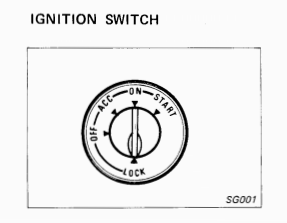Everything posted by SteveJ
-
Crankshaft Wrench Type
I just got my friend's reply: "Fill the air inlet of the impact with air tool oil, connect the air and then blast away at the nut. The oil prevents air from going out of the vanes of the impact, and will produce significantly more torque than just air."
-
Crankshaft Wrench Type
I think this is what my friend suggested. Otherwise, it's probably a matter of bolting the engine to something very solid and getting a four foot pipe to put over the end of a wrench (800 ft-lbs).
-
Crankshaft Wrench Type
I sent an email to a friend who gave another friend some suggestions on this same topic about a year ago. I'll let you know what he says.
-
S30 Z specialists near north Houston/Houston
Z Club of Texas is in the DFW area with the emphasis on Dallas. I don't think they have activities in Houston. I tried to find a Houston based Z club for someone who was on FB asking early Z questions, but it appears as though the Houston club folded a while back.
-
Buying my first z! But need help with identifying some things in the engine.
The carburetors installed on the car are Weber 32/36 downdraft carburetors. The air filters on those carburetors are typical for that type. The SU carburetors are side draft. The fuel rail definitely isn't stock. The stock fuel rail has a return. On this car the fuel rail is dead-headed going to the carburetors, and the line back to the tank has a redneck plug on it. As for how long the car has been sitting, my 73 has been sitting in my garage for 11 years, and it has less dust on the engine than this car.
-
Highest compression ratio with stock fuel injections
The purpose of the EGR is to reduce NOx. Octane won't affect that. A good cat might.
-
Highest compression ratio with stock fuel injections
He won't if the person doing the visual knows what to look for. That's the problem with California. You could modify a car to put out only carbon dioxide and water vapor, but if it doesn't have the factory parts, you fail emissions. Frankly, @280zdude could install a MS with an O2 sensor and tune it to have better tailpipe emissions, but he couldn't pass CA emissions because MS isn't CARB certified.
-
280z cranks but won’t start
LOCK - All power is off. Steering wheel lock is engaged. OFF - All power is off. Steering wheel is unlocked. ACC - Only accessories are powered (radio, fan, etc.). No engine power. ON - Accessories are powered. Engine components are powered. START - No accessory power. Engine components are powered. Solenoid is energized to engage the starter.
-
280z cranks but won’t start
No, the pump primes in the START position. Incomplete information. That's like saying "My feet hurt when I stand up" without you mentioning that you're barefoot and surrounded by Legos.
-
Let's show vintage racing pictures. I'll start.
Well, 76 in the bottom photo. 😉
-
Hanging out my shingle
I asked my wife to see if she could match the background color to the blue in the logo. She got pretty close with #101a66.
-
1976 280 Z from Ohio to Dubai
You better believe that the last time I was welding I was wearing a welding helmet, welding gloves, and a welding apron. Of course, since it was summer in Georgia, I was wearing a tank top. I got a good sunburn on my arms from the welder.
-
So much for cruising PCH
Well, the almost annual collapse of a section of PCH happened. If you watch the video, you'll see a gentleman with a 280ZX was interviewed. https://www.cnn.com/2021/01/30/us/big-sur-road-collapse-trnd/index.html
-
Hanging out my shingle
@dutchzcarguy - I designed this on Signs.com as an aluminum sign Dimensions are 24 inches wide by 6 inches tall. The font is "Headline News". Here is the logo I used: It looks to be $24 USD plus shipping.
-
Hanging out my shingle
-
Let's show vintage racing pictures. I'll start.
From the 2019 Mitty: https://photos.app.goo.gl/VxgzchtwdDmRiq3X9 https://photos.app.goo.gl/Kef8DP4QmWmeBref8 https://photos.app.goo.gl/VxgzchtwdDmRiq3X9 From the 2018 Mitty (Datsun was the featured marque): https://photos.app.goo.gl/4QDG93YOtzIidJqo2 https://photos.app.goo.gl/Pvn46wZtxfB9EAwt9 (with John Morton walking his line from under the bridge into the last turn) https://photos.app.goo.gl/HduDaGMcpIzEMFk63 https://photos.app.goo.gl/PXzS1oiRbWiyPENcA John Morton going through 10B
-
Hanging out my shingle
I bought the sign many years ago, and I don't remember where I got it from. It was probably ebay or Amazon. I saw this on ebay: https://www.ebay.com/itm/DATSUN-Parts-and-Service-Vintage-Metal-Wall-Sign-Plaque-Retro-Garage-Shed-Race/223538056895?hash=item340be80ebf:g:pLkAAOSwIbFc84KS I'll take a closer photo later.
-
Hanging out my shingle
Oh, I have been helping people out for a few years now. I just finally got smart enough to put the sign on the mailbox so they would stop missing the address. With the HOA, all of the mailboxes and houses look pretty much the same.
-
Hanging out my shingle
-
Let's show vintage racing pictures. I'll start.
I have a bunch of photos of cars doing that in Turn 10B at Road Atlanta.
-
280z cranks but won’t start
Let's be specific and precise. Is there still a plate in the driver's side door frame? Can you read the date? What I post assumes that this fits into what is considered the 1978 model year. If I understand you correctly, when you put the key in the START position, the solenoid engages the starter. The starter turns the engine, and the engine fires. (The car starts.) When you release the key to allow the switch to go from START on ON, the car dies immediately or shortly after. (It doesn't run.) I'm not sure what you mean by running the fuel pump right out of the fuel rail. I will have to assume that you have an adequate supply of good gasoline to supply the fuel pump. Here are two possible causes for your problem (though there can be others): The back part of the ignition switch is failing. The circuit for the fuel pump relay is losing the ground at the oil pressure switch. How to diagnose (You will need a multimeter, i.e.: a meter that can measure voltage and resistance.): Ignition Switch Put the meter on DC voltage. If it has ranges, select the lowest range that is above 12 volts (probably 20). Put the positive lead of the meter on the positive terminal of the coil (black wire with white stripe). Put the negative lead on an unpainted surface. I like the bolts of the shock tower. Have someone start the car. You should see around 10 to 12 volts while starting. When the key is released to go from START to ON, make sure you still have voltage. If the voltage drops to 0 when the key is in the ON position, that means the switch is bad. Oil Pressure Switch Put meter on the lowest resistance range. The oil pressure sender has a "T" connector. The oil pressure switch connects to the vertical of the "T". Get one probe in the back of the wire to test. The other probe goes to an unpainted surface. Again, I like the shock tower bolts. Have someone start the car. As the car starts, you should see the resistance measurement go to zero (continuity). If the resistance does not drop, that means you don't have the probe positioned properly, or the oil pressure switch is bad. Let us know the results of these tests. Also, post pictures of you holding the leads in place and of the meter. Please don't post potato quality pictures. Sometimes people don't use the proper technique, and that provides bad results. I don't want you throwing parts at the problem. That gets expensive and frustrating.
-
Starting Carb Conversion: Flat Tops to Paltechs
To go with @Racer X's comments, hardware kits: https://www.thezstore.com/page/TZS/CTGY/classic19o And header gaskets: https://www.thezstore.com/page/TZS/CTGY/classic19a
-
Ammeter acting up
Since you kept talking about it, @Captain Obvious, I decided to take the plunge. 😉 While @Dave WM is trying to see if it's just the meter, the description of the behavior during the trip tells me it is the charging system itself acting up. By the way, Dave, I like the current monitoring setup. The ammeter I linked would work the same way. As long as the place you clamp the meter feeds the white wire in the wiring harness, you should be good. You may want to get a voltmeter that plugs into your cigarette lighter, too. The lights getting brighter tells me your voltage is going up during the issue. I'm betting you'll see the voltage go up when the ammeter says you have current flowing to the battery. The ammeter behavior seen in your video looked typical to me. You have the voltage drop from starting the car, so the alternator is replacing the battery's loss. You didn't have to crank long, so it doesn't take long for the battery to get back to a sufficient level, dropping the alternator output. Let's consider the operation of the VR as laid out in the wiring diagram. As the neutral of the alternator builds sufficient voltage, it energizes its coil in the VR. The contact that closes provides a ground for the second coil that is powered by the battery. Note that this second coil is wired in series with a resistor, probably to drop off the voltage and cause the coil to de-energize should battery voltage drop from discharging. When coil 2 is de-energized, the switched voltage is going straight to the field wire on the alternator (full field voltage). When coil 2 is energized, the switched voltage goes to two resistors (voltage divider) to reduce the voltage going to the alternator field, dropping the alternator output. From reviewing http://www.secondchancegarage.com/public/83.cfm it's obvious for the mechanical VR the contacts would constantly open and close. With a solid state VR, you have discrete components handling the same function in a similar manner. Here's the thing. If the VR is not dropping the voltage going to the field wire, you're going to see increased output from the alternator. Keep in mind that a flaky ground at the VR could present itself in a similar fashion. I am assuming you're running a solid-state VR. Also, a flaky neutral could also cause the problem. It could also be a winding issue in the alternator if the grounded leg has a winding shorting out close to the neutral. (I don't think you would have an intermittent short on a winding, though. I don't have enough practical experience to say one way or the other.) Ideally, it would be great to monitor the voltage on the white/black wire with an oscilloscope. You would expect it to fluctuate too much for a typical voltmeter. Monitoring the voltage to ground on the neutral might reveal good data, too. Okay, now I need to find all of my O-scope probes so I can see if I can configure something for an educational video.
- 1976 280Z Restoration Project
-
Another ebay car....
It looks like it might have had floor repairs, but what caught my eye was "unrestored" in the description of the car. You can clearly see overspray and paint flaking around the door jamb tag. Given what we have seen from "Beverly Hills" lately, I hope people look for another car.












